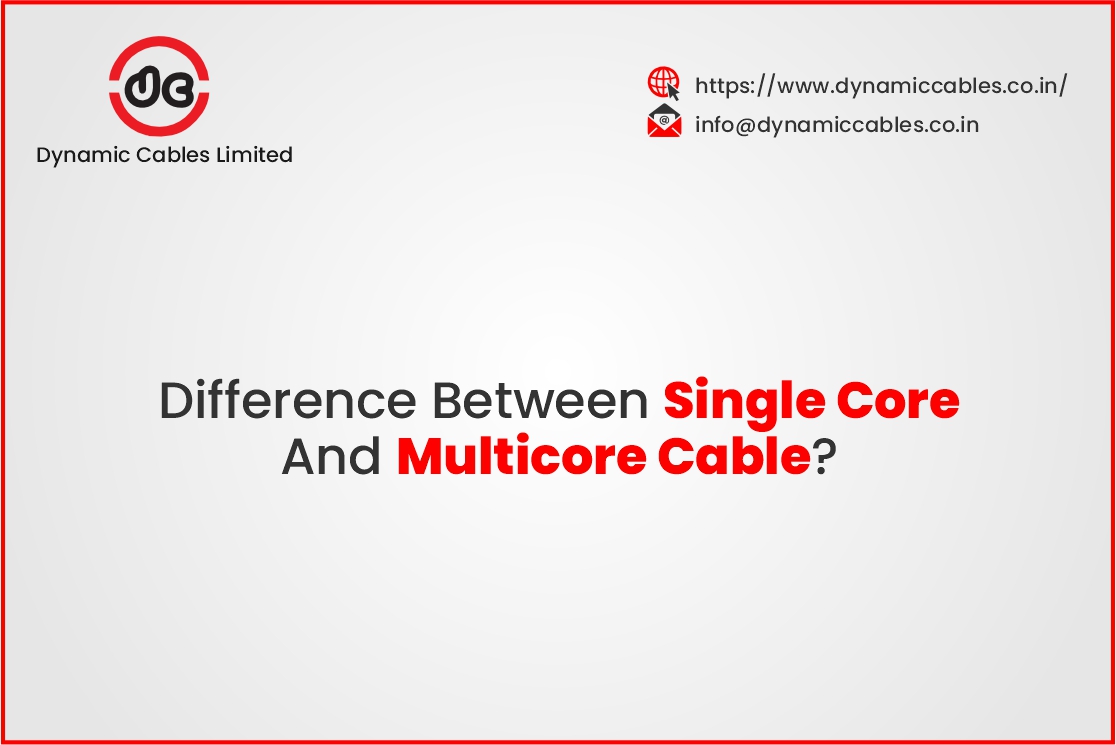- An ISO 9001:2015, 14001:2015 & 45001:2018 Company

Difference between single core and multicore cable?
When it comes to electrical wiring, one of the key decisions that need to be made is whether to use single-core cables or multicore cables. Both types of cables are commonly used in various electrical installations but differ in design, functionality and applications. Understanding these differences is crucial for selecting the right cable for your needs. Dynamic Cables, a leading electrical cable manufacturer, offers a wide range of cables that meet national and international standards, ensuring high performance and reliability.
What Are Single Core Cables?
Single-core cables, as the name suggests, consist of only one conductor. The conductor is typically made from copper or aluminium, which provides excellent electrical conductivity. These cables are commonly used for applications requiring only one conductor, such as power supply systems, lighting, or connecting electrical equipments.
Single-core cables are often used in environments where the cable is routed in a straight line or through conduits. Since they are relatively simpler in construction, they are typically more affordable and easier to handle during installation. However, because they contain only a single conductor, they are more prone to external interference and must be insulated properly to prevent electrical faults.
What Are Multicore Cables?
In contrast, multicore cables contain multiple conductors, typically arranged in a twisted or bundled configuration. These conductors are often insulated separately, allowing for numerous electrical connections within a single cable. Multicore cables are designed for more complex applications that require multiple conductors to carry signals, power, or data.
Multicore cables are used in various industries and applications, including telecommunications, audio systems, control panels, and electrical systems that require multiple conductors. The design of multicore cables provides added flexibility and can reduce the need for separate cables for each conductor, simplifying the wiring process.
Key Differences Between Single-Core and Multicore Cables
-
Number of Conductors:
- Single Core Cables:These contain a single conductor and are ideal for simple applications requiring only one wire.
- Multicore Cables:Contain multiple conductors within a single outer sheath, making them suitable for more complex applications requiring multiple connections.
-
Applications:
- Single Core Cables: Typically used for high voltage power transmission, in low-voltage systems, power distribution, and electrical equipment where a single connection is sufficient. Single core cables are
- Multicore Cables:Ideal for more intricate applications such as control circuits, audio systems, telecommunications, and industrial automation, where several conductors are needed for different functions.
-
Flexibility and Handling:
- Single Core Cables:Generally less flexible, as they consist of a single, rigid conductor. These cables are often used in fixed installations or conduits.
- Multicore Cables:More flexible due to the multiple conductors bundled together, making them ideal for applications requiring mobility or installations with complex routing needs.
-
Cost:
- Single Core Cables:Typically more affordable due to their simpler construction and lower material costs.
- Multicore Cables:Multicore Cables tend to be more expensive, as they require more materials (such as multiple conductors and individual insulation) and involve a more complex manufacturing process.
-
Installation:
- Single Core Cables: These are easier to install in applications with only one connection. However, they may require additional effort in cases where multiple conductors are needed, as separate cables must be used. Single core cables require more accessories as compered to multicore cables.
- Multicore Cables: These are more convenient for installations that require several connections, as they combine various conductors in a single sheath. This simplifies the installation process and reduces the need for multiple cables.
-
Interference and Signal Integrity:
- Single Core Cables: More susceptible to electromagnetic interference (EMI) due to the lack of shielding or twisting. This can lead to signal degradation in sensitive applications.
- Multicore Cables:Often provide better resistance to EMI due to their design, especially when the cores are twisted or shielded. This makes them ideal for applications that require high-quality signal transmission.
Why Choose Dynamic Cables for Your Cable Needs?
As a leading electrical cable manufacturer, Dynamic Cables understands the importance of choosing the right cable for your specific requirements. Whether you need single-core cables for straightforward applications or multicore cables for more complex wiring needs, we provide high-quality products that meet international standards. Our cables are designed for optimal performance, durability, and safety in various environments, ensuring your electrical systems run smoothly and efficiently.
At Dynamic Cables, we offer a wide range of single-core and multicore cables tested for quality and reliability. Our commitment to innovation and customer satisfaction makes us a trusted name in the cable manufacturing industry.
Conclusion
In conclusion, the choice between single-core and multicore cables depends on the specific requirements of your electrical system. Single-core wires are ideal for simpler applications where only one conductor is needed, while multicore cables are better suited for more complex systems requiring multiple connections. By understanding the differences between these two types of wires, you can make an informed decision, ensuring your electrical installations' efficiency, reliability, and safety. When choosing your cables, trust Dynamic Cables, a renowned electrical cable manufacturer, to provide high-quality solutions tailored to your needs.
 English
English

 C701, Tower-C, Noida One
C701, Tower-C, Noida One
